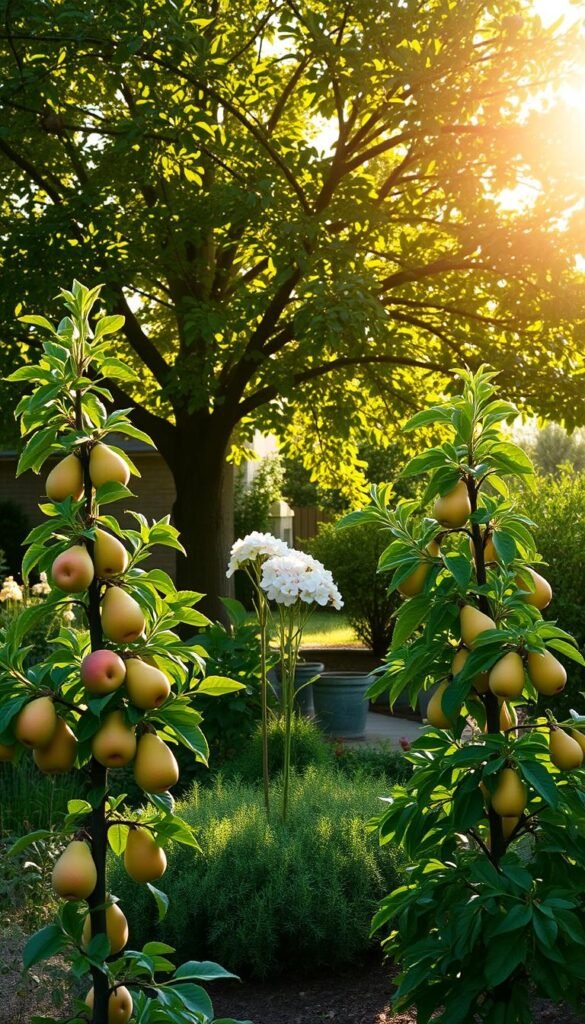There’s nothing quite like plucking a sun-warmed treat straight from your outdoor space. Whether you’re working with a cozy balcony or a sprawling backyard, many compact plants thrive in various environments. You don’t need professional skills to enjoy nature’s sweetness—just smart choices that match your lifestyle.
Urban dwellers often think they lack room for productive plants, but modern dwarf varieties fit perfectly in containers. Suburban homeowners can experiment with larger specimens that become living landmarks. The key lies in selecting species that grow well without constant attention.
Your success starts with resilient options that handle occasional missed waterings or imperfect soil. Many self-pollinating types simplify care while delivering colorful blossoms and juicy rewards. From spring’s first buds to autumn’s final yield, these plants transform your space through every season.
Beyond fresh snacks, you’ll create a vibrant habitat for pollinators and birds. Imagine sipping morning coffee beside flowering branches that later become dessert ingredients. With thoughtful selection, your green corner becomes both pantry and sanctuary—proof that good things truly grow on trees.
Understanding the Basics of Fruit Tree Gardening
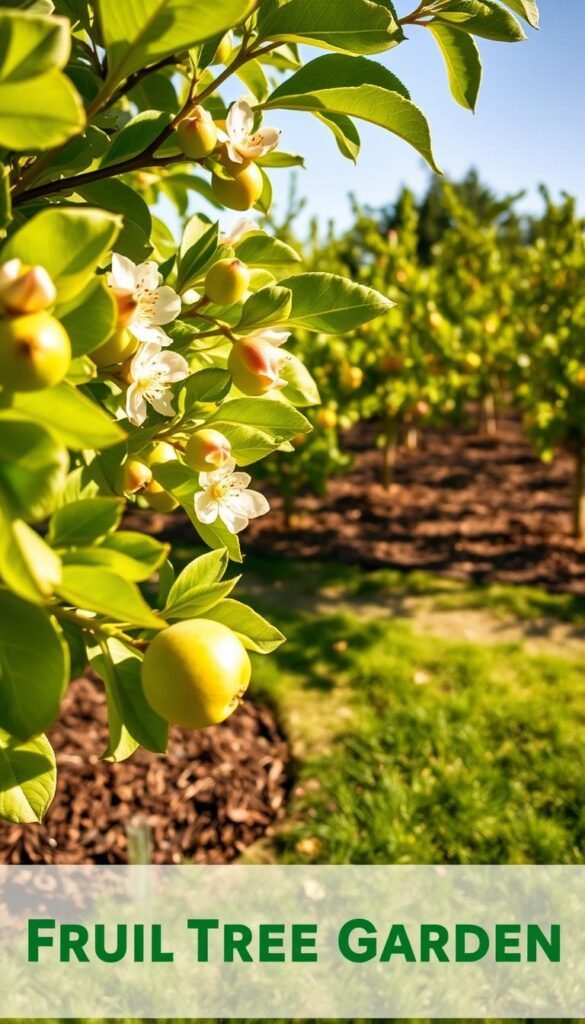
Your journey to fresh-picked abundance begins with foundational knowledge. While store shelves offer convenience, nothing matches the thrill of nurturing life from soil to snack. Let’s explore how simple decisions can yield delicious rewards.
Why Homegrown Tastes Better
Ripe-to-table eating transforms ordinary moments. Commercial growers often harvest early for transport, sacrificing flavor. When you control the timeline, fruits develop complex sugars and aromas impossible to mass-produce.
Beyond taste, growing edibles creates meaningful connections. You’ll discover:
- Pride in serving meals featuring your harvests
- Savings on organic produce over time
- Joy in sharing extras with neighbors
Smart Space Planning Tips
Every yard holds hidden potential. Start by tracking sunlight patterns—most fruiting plants need 6+ hours daily. Test soil drainage by digging a 12-inch hole: if water remains after an hour, consider raised beds.
Vertical solutions double your capacity. Espalier-trained specimens thrive against fences, while dwarf varieties flourish in containers. Notice sheltered spots where buildings block wind—these microclimates protect delicate blossoms.
Remember: starting small prevents overwhelm. Two well-chosen plants often outperform a crowded orchard. As confidence grows, so can your edible landscape.
Choosing the Right Fruit Trees for Your Garden
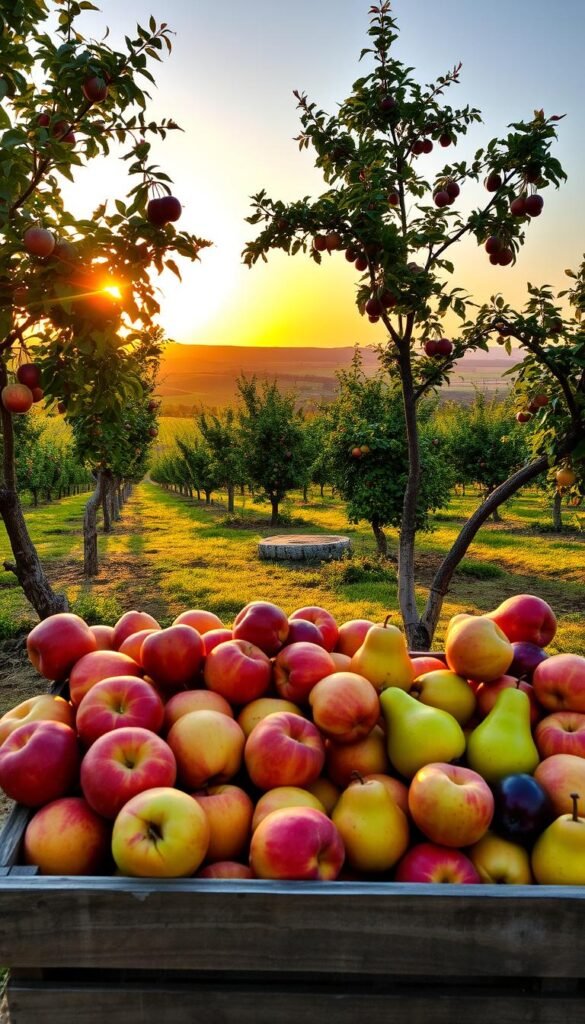
Selecting the perfect additions to your edible landscape requires matching nature’s needs with your own. Three key factors determine success: available space, sunlight patterns, and soil quality. Getting these elements right creates a thriving environment with minimal fuss.
Space, Sunlight, & Soil Considerations
Sun exposure makes or breaks your harvest. Most productive species need 6-8 hours of direct light daily. Watch how shadows move across your yard before digging that first hole.
Well-draining earth prevents soggy roots while holding moisture. Test your ground by filling a 12-inch hole with water—if it drains within 24 hours, you’re golden. For clay-heavy areas, mix in compost to improve texture.
Measure twice, plant once. Consider mature heights and spreads to avoid overcrowding. Dwarf types stay under 8 feet tall, perfect for tight spaces. Semi-dwarf varieties offer more yield while fitting suburban lots.
Assessing Maintenance Needs
Some species demand frequent pruning and pest control. Others thrive with occasional attention. Ask yourself: How much time can you realistically dedicate weekly?
Local climate plays a huge role. Peaches adore warm summers, while apples handle colder zones. Check your USDA hardiness zone against variety requirements. Remember: Resilient options like figs or persimmons often outperform fussier cousins.
Start with one or two low-effort picks. As confidence grows, expand your orchard gradually. The right choices today mean juicy rewards for years ahead.
Garden Fruit Trees for Beginner Growers: Low-Maintenance Varieties to Try First
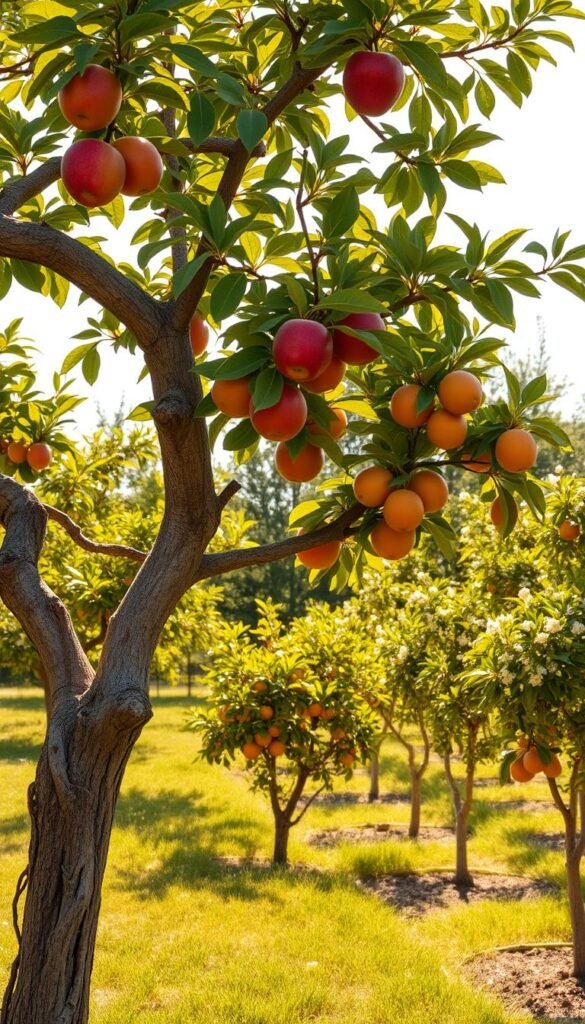
Starting your edible oasis begins with selecting resilient varieties that thrive with minimal effort. Four standout options—pear, apple, fig, and citrus—lead the pack for new growers. These plants adapt to various soils and bounce back from occasional neglect, making them ideal for busy lifestyles.
Why do these species excel for novices? They’re naturally disease-resistant and tolerate imperfect watering schedules. Many self-pollinate, so you won’t need multiple specimens to get fruit. Dwarf versions fit patios, while standard sizes work for yards with ample space.
Consider these traits when choosing:
- Proven drought tolerance reduces watering stress
- Compact growth habits simplify pruning
- Wide climate adaptability increases success rates
Once comfortable with basic care, expand to plum, cherry, or peach trees. These require slightly more attention to soil pH and pest management but reward effort with summer-ripe treats. Stick to one or two types initially—master their needs before diversifying.
Consistent care yields sweet results. Water young specimens weekly until established, then rely on rainfall. Apply balanced fertilizer each spring and prune dormant branches to maintain shape. With these simple steps, you’ll enjoy armfuls of fruit within 2-3 growing seasons.
Exploring Self-Pollinating and Companion Trees
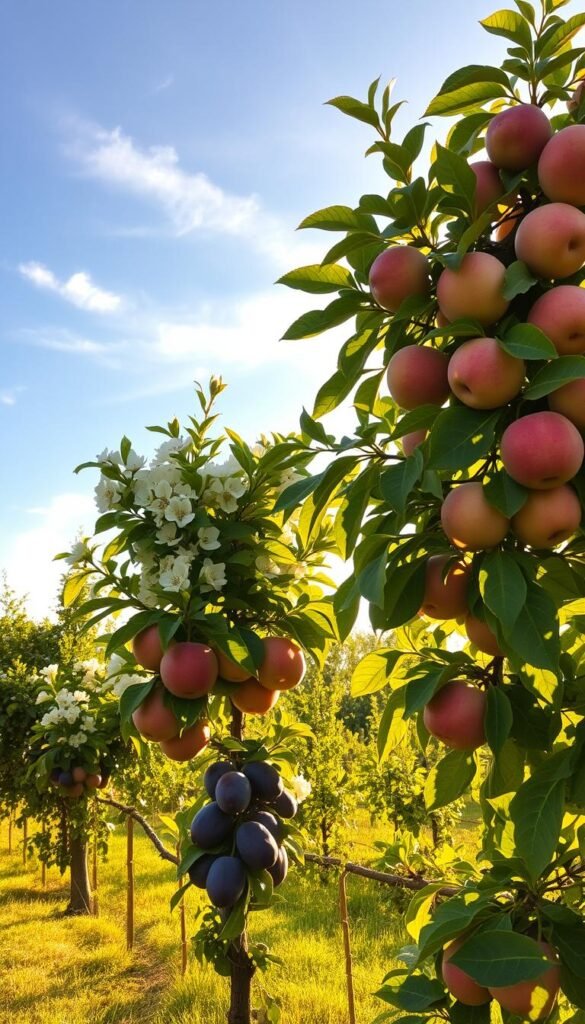
Your orchard’s productivity hinges on pollination strategies. While some varieties work solo, others need partners to thrive. Understanding these relationships helps maximize yields without overcrowding your space.
Self-Pollinating Varieties Explained
Apricots, nectarines, and peaches handle reproduction independently. Their flowers contain both male and female parts, letting single specimens produce fruit without cross-pollination. Sour cherries join this group too—perfect for small yards where space matters.
These independent growers simplify planning. Plant one tree and still enjoy baskets of harvests. “Self-fertile types let beginners focus on care basics rather than complex pollination schedules,” notes Oregon nursery owner Marie Tulin.
When You Need a Pollinator
Apples, pears, and sweet cherries require partners. Most need different variety planted within 50 feet. Bloom timing matters most—early and late-flowering types won’t sync up. Nurseries provide charts showing compatible pairs for your region.
Smart pairing boosts yields dramatically. Even self-pollinating trees produce 20-30% more fruit with companions. Try these combinations:
- Honeycrisp apple + Golden Delicious
- Bartlett pear + Anjou
- Bing cherry + Stella
Remember: pollinators don’t need matching fruit types. Crabapples can service regular apples, saving space while adding spring blooms. Track flowering weeks like you’d track a favorite TV show—miss the window, and you’ll get reruns instead of fruit.
Tips for Planting and Caring for Your Fruit Trees in Different Climates
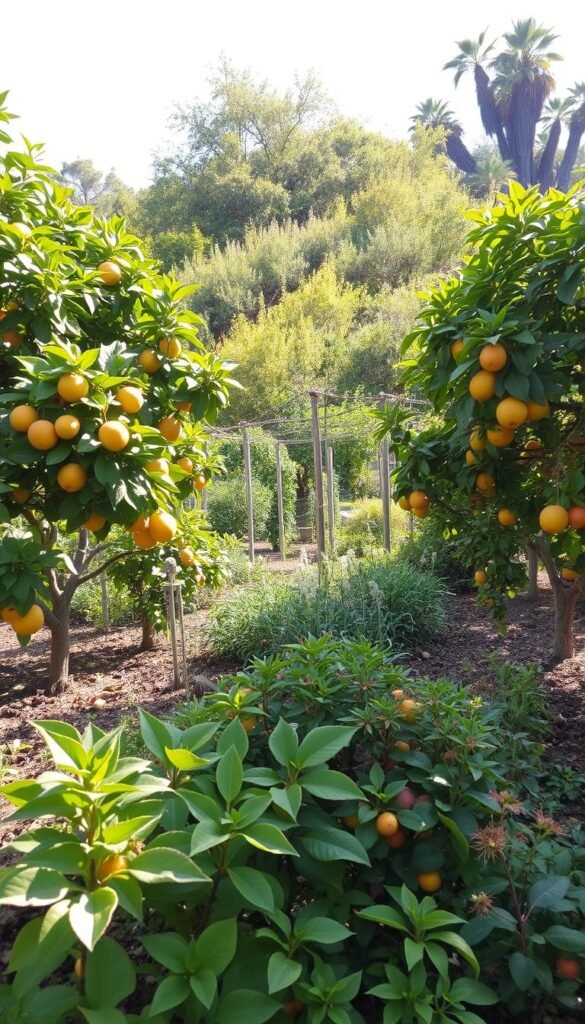
Smart climate adaptations turn good harvests into great ones. Whether you’re battling icy winters or scorching summers, matching your care routine to local weather patterns ensures healthy growth. Let’s explore how to work with your environment rather than against it.
Planting in Full Sun vs. Partial Shade
Sunlight fuels sugar production in developing fruits. Most specimens need 6-8 hours of direct light daily. Southern gardeners should position plants where afternoon shade protects against heat stress. Northern growers often maximize sun exposure against warm walls.
Some apples and pears handle 4-5 hours of sunlight if needed. Test your site with a sunlight-tracking app for accuracy. Remember: More sun typically means sweeter rewards at harvest time.
Adjusting Care for Seasonal Changes
Spring demands balanced fertilizer to support blossoms. Summer calls for deep watering every 10-14 days—more often during droughts. Come fall, clear fallen leaves to prevent disease. Winter requires pruning dormant branches and wrapping trunks in cold zones.
Watch for these climate signals:
- Early bud break? Protect blossoms from late frosts with row covers
- Dry summer spell? Mulch roots with 3″ of wood chips
- Mild winter? Delay pruning until coldest weather passes
Create microclimates using fences or stone walls to extend growing seasons. A south-facing brick wall can boost heat for figs in cooler areas. With smart adjustments, your plants thrive in nearly any zone.
Container Gardening: Maximizing Space with Fruit Trees
Transforming tight corners into productive spaces starts with smart container choices. Urban settings and small yards become lush orchards when you match the right plants with strategic setups. Even chilly regions can host citrus specimens through seasonal adjustments.
Selecting Compact Varieties
Dwarf types shine in confined areas. Look for genetic dwarfs labeled specifically for container use—these stay under 8 feet tall naturally. Semi-dwarf options work too but need occasional pruning. For USDA zones 8-11, Meyer lemons and Calamondin oranges thrive outdoors year-round.
Your pot selection matters as much as the tree. Choose 15-20 gallon containers with multiple drainage holes. Lightweight fiberglass works best for movable setups. “I’ve moved my Key lime indoors every winter for 12 years—it still fruits heavily,” shares Arizona grower Luis Marquez.
Three care essentials boost success:
- Water when the top 2 inches of soil dry out
- Use slow-release fertilizer spikes every spring
- Rotate pots monthly for even sun exposure
Northern growers can push boundaries by sheltering plants during freezes. Wrap containers in bubble wrap or roll them into garages when temperatures plummet. Refresh potting mix every third year to maintain nutrient levels and root health.
Seasonal Planting and Maintenance Guidelines
Timing your planting and care routines with nature’s calendar unlocks healthier growth. By syncing with seasonal rhythms, you help specimens establish strong foundations while minimizing stress. This approach reduces guesswork and maximizes your harvest potential.
Spring Planting and Early Care
Early spring offers ideal conditions for root development. Plant after the last frost date when soil becomes workable. New additions need weekly deep watering—about 10-15 gallons—to encourage downward root growth.
| Planting Time | Best For | Advantages | Considerations |
|---|---|---|---|
| Spring | Most varieties | Full growing season | Avoid soggy soil |
| Fall | Fast-growing types | Mild winter prep | Frost risk management |
Fast-growing options like plums can handle autumn planting in zones 7-9. Position them on elevated ground where cold air drains away. Mulch with straw to insulate roots during temperature swings.
Winter Pruning and Protection
Dormant-season trimming shapes structure and prevents disease. Remove branches rubbing against others or showing discoloration. “Clean cuts at 45-degree angles heal fastest,” advises arborist Lila Chen.
Wrap young trunks with burlap if temperatures drop below 20°F. Apply dormant oil spray to smother overwintering pests. Complete these tasks before buds swell in late winter to avoid disrupting new growth.
Your annual care schedule should include:
- Spring: Balanced fertilizer & blossom monitoring
- Summer: Pest checks & hydration management
- Fall: Leaf cleanup & soil testing
- Winter: Structural pruning & trunk protection
Spotlight on Low-Maintenance Varieties: Plums, Peaches, Pears & Cherries
Imagine stepping outside to pick fresh, juicy snacks from your own backyard—no green thumb required. These four classic picks deliver flavor without demanding constant attention. Their forgiving nature makes them ideal for new enthusiasts seeking quick wins.
Insights on Plum and Peach Trees
Plum trees thrive where others struggle. Their compact size suits urban spaces, and they handle different soil types better than most. Choose European types for sweet snacking or Japanese varieties for early harvests. Just remember: plant two different kinds to ensure pollination.
Peaches bring summer sunshine to your table. These sun-lovers need well-drained soil but reward you with velvety fruits perfect for baking. Look for disease-resistant cultivars like ‘Reliance’ to minimize spray routines. A single tree can produce 50+ pounds annually once established.
Tips for Growing Pears and Cherries
Pear trees laugh off pests that plague other species. Their crisp fruits ripen off the branch, so you can store them for weeks. Pair ‘Bartlett’ with ‘Bosc’ for cross-pollination magic. Pro tip: let pears mature on the counter—they sweeten after picking.
Cherry trees double as landscape stars with their spring blossoms. Tart varieties like ‘Montmorency’ handle colder zones, while sweet types prefer moderate climates. Birds love them too, so plan protective netting if you want to beat our feathered friends to the harvest.

